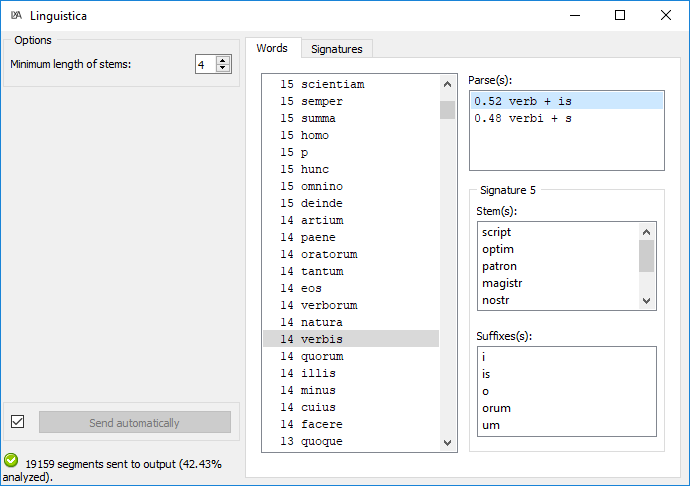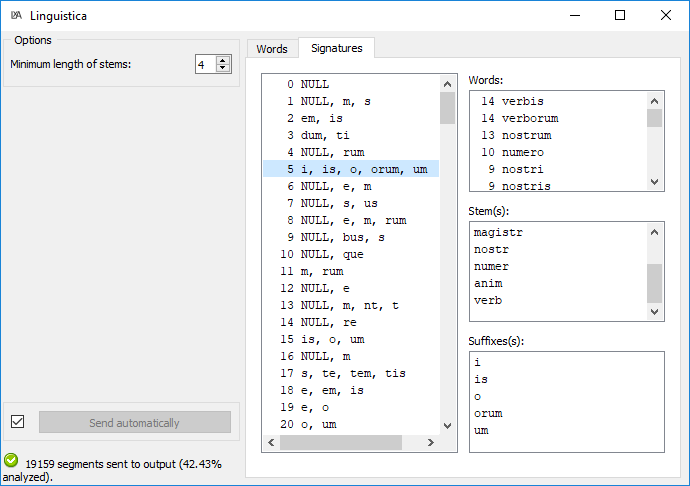Linguistica¶

Unsupervised morphological analysis.
Author¶
Aris Xanthos
Signals¶
Input:
Word segmentationA Textable segmentation containing words
Outputs:
Morphologically analyzed dataA Textable segmentation containing the same words annotated with the discovered morphological structure (stem, suffix, and signature)
Description¶
This widget takes a word segmentation as input and applies part of John Goldsmith’s “Crab Nebula” algorithm to it. The algorithm seeks to discover morphological structure in an unsupervised fashion, i.e. without using language-dependent linguistic resources.
In particular, the widget tries to divide each word into stem and a suffix, in a way that the resulting components can be regularly combined with other stems and suffixes (thus forming a structure known as a “signature”).
Interface¶
The widget’s interface displays a single control (see figure 1 below): the user can set the minimum length allowed for a stem (4 characters is the default value).

Figure 1: Linguistica widget interface (Words tab).
The right hand side of the interface contains two tabs that can be used to explore the discovered morphology. The Words tab displays the list of input words ordered by decreasing frequency. When a word is selected in this list, the possible parses are displayed in the Parse(s) section, along with a probability estimate (NB: at this point the estimation is excessively biased toward parses involving the “NULL” suffix, i.e. the empty string). When a parse is selected, the stems and suffixes that belong to the corresponding signature are displayed in the Stem(s) and Suffixe(s) lists. The signature’s identifier (an integer) is also indicated.

Figure 2: Linguistica widget interface (Signatures tab).
The Signatures tab displays the list of discovered signatures, along with their identifier. When a signature is selected, the corresponding words, stems and suffixes are displayed in the other lists.
The Info section indicates that the input has been correctly processed, or the reason why no output is emitted (no input, etc.). It also indicates the proportion of tokens that have been assigned to a signature (with the exception of the signature #0, which always contains all the stems that have only been found to occur with the NULL suffix).
The Send button triggers the computation and emission of the annotated word segmentation. When it is selected, the checkbox to the left of the button disables the button and the widget attempts to automatically emit results at every modification of its interface.
Messages¶
Information¶
- <n> segments sent to output (<p>% analyzed).
- This confirms that the widget has operated properly.
Warnings¶
- Unable to find any stems in data.
- The morphology learning algorithm has not been able to discover any relevant structure.
- Unable to find any stems in data. Please check that they are segmented into words.
- The morphology learning algorithm has not been able to discover any relevant structure, and a likely explanation is that the input has not been segmented before being transmitted to this widget. If so, please segment it into words (for example using Textable’s Segment widget).
- Settings were changed, please click ‘Send’ when ready.
- Settings have changed but the Send automatically checkbox has not been selected, so the user is prompted to click the Send button (or equivalently check the box) in order for computation and data emission to proceed.
- Widget needs input
- A Textable segmentation containing words should be input in the widget.